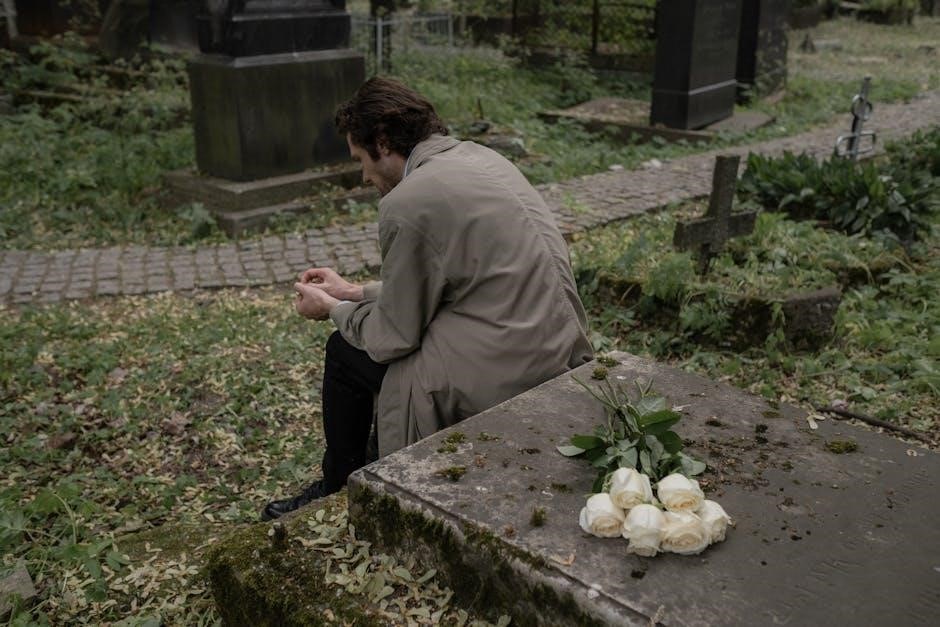7 stages of grieving pdf
The concept of grieving is introduced through various models‚ including the 7 stages of grieving‚ which is widely accepted and discussed in numerous online resources and documents‚ such as pdf files available for download.
Definition and Overview
The 7 stages of grieving refer to a model that describes the emotional and psychological process individuals experience when dealing with loss or grief. This model is widely discussed in various online resources‚ including pdf files‚ which provide an in-depth explanation of each stage. The definition of the 7 stages of grieving is rooted in the idea that grief is a natural response to loss‚ and that individuals go through a series of emotions in order to come to terms with their loss. An overview of the model reveals that it is a complex and dynamic process‚ influenced by various factors‚ including the nature of the loss‚ the individual’s personality‚ and their support system. The 7 stages of grieving pdf files available online provide a comprehensive understanding of this model‚ allowing individuals to better navigate their grief and find support during a difficult time. The information provided in these resources is invaluable for those seeking to understand the grieving process.

The 7 Stages of Grief Model
The model outlines a process of emotional and psychological stages‚ providing a framework for understanding grief‚ available in pdf files for further study and reference online always.
Stage 1: Shock and Denial
The initial stage of grieving is characterized by shock and denial‚ a natural response to a significant loss‚ as outlined in various online resources and pdf files. This stage allows individuals to process the news‚ and it may involve feelings of numbness and disorientation. The shock and denim stage serves as a coping mechanism‚ providing emotional protection from the overwhelming pain of the loss. It is a temporary state‚ and as the reality of the situation sets in‚ individuals will begin to transition to the next stage of grieving. The duration of this stage can vary‚ but it is an essential part of the grieving process‚ as discussed in numerous pdf files and online articles on the topic of grieving and loss. The information available online provides a comprehensive understanding of this stage and its significance in the grieving process.
Stage 2: Pain and Guilt
As the initial shock begins to wear off‚ the reality of the loss sets in‚ and individuals enter the stage of pain and guilt‚ a critical component of the grieving process‚ as discussed in various pdf files and online resources. This stage is characterized by intense emotional pain‚ regret‚ and self-blame‚ which can be overwhelming and debilitating. The pain and guilt stage is a natural response to the loss‚ and it allows individuals to confront their emotions and begin to process the reality of their situation. Online resources and pdf files provide guidance on navigating this stage‚ emphasizing the importance of acknowledging and working through these emotions. By doing so‚ individuals can begin to heal and move forward‚ eventually transitioning to the next stage of the grieving process. The information available online offers valuable insights into this stage‚ helping individuals understand and cope with their emotions.

Understanding the Grieving Process
The grieving process is complex‚ involving emotional and psychological changes‚ as discussed in various online resources and pdf files‚ providing valuable insights and guidance.
Grief as a Natural Response to Loss
Grief is a natural response to loss‚ and it is experienced by individuals in various ways‚ as discussed in online resources and pdf files. The intensity and duration of grief can vary greatly from person to person‚ depending on the nature of the loss and the individual’s coping mechanisms. Grief can be triggered by the loss of a loved one‚ the end of a relationship‚ or any other significant life change. It is a complex emotional and psychological process that involves a range of feelings‚ including sadness‚ anger‚ guilt‚ and acceptance. Understanding grief as a natural response to loss is essential for providing support and guidance to those who are experiencing it. By acknowledging the normalcy of grief‚ individuals can begin to process their emotions and work towards healing. This understanding can also help to reduce feelings of isolation and stigma associated with grief.
Factors Influencing the Grieving Process
Several factors can influence the grieving process‚ including the nature of the loss‚ the individual’s personality and coping mechanisms‚ and their support system. The relationship with the person who has been lost can also play a significant role in shaping the grieving experience. Additionally‚ cultural and societal norms can impact how individuals express and process their grief. The availability of social support‚ such as friends‚ family‚ and mental health professionals‚ can also influence the grieving process. Furthermore‚ individual differences in emotional expression‚ attachment style‚ and resilience can affect the intensity and duration of grief. Understanding these factors can help individuals and professionals provide more effective support and guidance to those who are grieving. By recognizing the complexities of the grieving process‚ it is possible to develop more nuanced and compassionate approaches to supporting individuals through difficult times. This can involve tailoring support to the individual’s unique needs and circumstances.

Applications of the 7 Stages of Grief Model
The model is applied in various fields‚ including psychology and counseling‚ to help individuals cope with loss and grief‚ using online resources like pdf files for guidance and support always.

Personal Loss and Grief
Personal loss and grief can be a devastating experience‚ affecting individuals in different ways‚ as discussed in various online resources‚ including pdf files available for download. The 7 stages of grieving model provides a framework for understanding the emotional journey of individuals who have experienced loss. This model is often used to help people cope with the emotional impact of loss‚ such as the death of a loved one‚ divorce‚ or other significant life changes. By understanding the different stages of grief‚ individuals can better navigate their emotions and work through the healing process. Online resources‚ including pdf files and articles‚ offer guidance and support for those experiencing personal loss and grief‚ providing a valuable tool for those seeking to understand and manage! their emotions during a difficult time‚ with many resources available to help individuals cope with their loss.
Professional Applications
The 7 stages of grieving model has numerous professional applications‚ particularly in fields such as counseling‚ psychology‚ and social work. Professionals in these fields often use the model to help clients understand and process their emotions‚ as discussed in various online resources‚ including pdf files available for download. The model provides a framework for assessing and addressing the emotional needs of clients who have experienced loss‚ and can be used to develop targeted interventions and support strategies. Additionally‚ the model can be used in training and education programs for professionals‚ helping to increase their understanding of the grieving process and improve their ability to provide effective support to clients. Many professional organizations and institutions offer resources and training on the 7 stages of grieving model‚ including pdf files and online courses‚ to help professionals apply the model in their work. This can be a valuable tool for professionals working with clients who have experienced loss.
